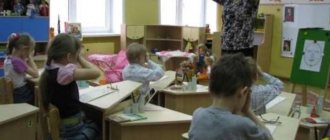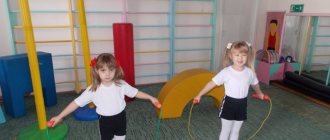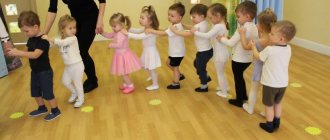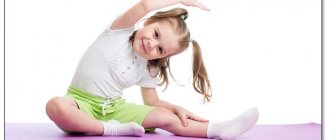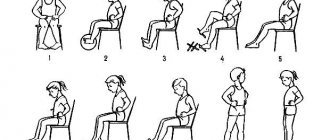The development of the visual apparatus begins in the womb, and is completed only by the age of 12 - before this age it is easy to worsen an already fragile system. A predisposition to myopia, farsightedness and other visual impairments in children can lead to dire consequences due to overwork, heavy workload at school, or simply due to a cold. Unfortunately, few people think that eye exercises should begin in childhood - at this time it is most effective and gives greater results. When school begins, a child is bombarded with a large amount of information; he has to sit a lot and move little; besides, not all schools have furniture that cares about the child’s health or simply does not harm him - all this leads to overwork, fatigue, eye strain. Therefore, it is important to do eye exercises for children both during classes at school and at home.
Why do children need eye gymnastics?
Children's eye gymnastics differs from others in that it is accompanied by poems, songs, sayings and sayings - this makes it easier to interest the child so that the exercises do not become something unpleasant. The purpose of children's gymnastics is not just to relax the eyes and relieve tension, but also to train the eye muscles while they are still developing.
Goals of children's eye exercises
Eye gymnastics for children is focused more on training the eye muscles, because the future of the child’s vision depends on them. Sets of exercises: ● calm the nervous system;
● help process the information received;
● lighten the load, relieve eye fatigue;
● slow down or completely prevent vision deterioration.
These are the main functions of eye gymnastics for children. With daily exercises recommended by ophthalmologists, the result will be noticeable.
Indications for performing eye exercises for children
In order to choose the right set of exercises for your child yourself, you need to visit a specialist. If there are complaints, this is a must.
In what cases is eye exercise recommended:
● with a tendency to visual impairments: myopia, farsightedness, astigmatism;
● if the child complains of eye fatigue or pain in the forehead (may occur due to eye strain);
● if the child spends a lot of time reading books, watching TV, playing games on the phone or on the computer;
● for vision problems;
● for serious illnesses.
Eye exercises for myopia
Exercises for myopia help stop its progression and improve visual acuity after visual stress. Charging is very simple:
- relieve tension from the eye muscles by blinking frequently;
- close your eyes and relax;
- sit up straight, look forward and draw straight lines up and down;
- draw a few circles with your gaze in one direction and the other;
- tilt your head back and look at the ceiling, then look at the floor;
- close your eyes and rotate your head several times in different directions.
For myopia, not only eye exercises are effective, but also general strengthening exercises that help improve blood circulation.
Gymnastics for preschool children
For preschool children, simple, interesting and exciting exercises are provided in order to mostly develop the child’s habit and interest in eye gymnastics.
A lesson in an educational preschool educational institution - a preschool institution - is divided into three stages:
- warm-up,
- main part,
- conclusion.
In kindergarten, a teacher conducts a lesson. Parents can do this at home.
Warm-up begins with the usual movement of the eyes up and down, then from side to side. Then relaxation - close your eyes with your hands and count to five.
The main part includes exercises - more complex combinations of eye movements.
● “Pinocchio” - you need to look at the tip of the nose, then imagine how it grows, and then decreases again. The main condition when performing this exercise: children should not grimace.
● “Faces” - children imagine themselves in the role of animals and imitate them: squinting, making faces, etc.
● “Geometric shapes” - the teacher invites children to draw geometric shapes with their eyes.
At the end of the gymnastics, children from 3 years old draw with their noses - pictures are hung on the board - images of different animals, transport, fruits and objects for preschoolers. Children need to repeat the drawing with their eyes. Gymnastics for the eyes in pictures was created specifically to captivate children with a process beneficial to their health.
Children's gymnastics for the eyes in verse
Poems in children's gymnastics for the eyes can be used both in kindergartens and in lower grades of school. Here are a few rhymes for physical education minutes to warm up tired eyes in kids:
“Your eyes need a rest.” (Everyone closes their eyes) “You need to take a deep breath.” (We take a deep breath. Eyes are still closed) “The eyes will run in circles.” (The eyes are open. We turn the pupil in a circle clockwise and counterclockwise) “They will blink many, many times” (We blink our eyes quickly) “The eyes feel good.” (Lightly touch our eyes with our fingertips) “Everyone will see my eyes!”
And this verse gymnastics for the eyes will help children remember the days of the week and help prevent eye diseases:
All week in order, Eyes doing exercises. On Monday. When they wake up, their eyes will smile at the sun, they will look down at the grass and back up to the heights. (Raise your eyes up; lower them down, head does not move)
On Tuesday, the watch-eyes, They look here and there, They walk to the left, they walk to the right They will never get tired. (Turn your eyes to the right, then to the left, the head does not move)
On Wednesday we play blind man's buff, close our eyes tightly. One, two, three, four, five, Let's open our eyes. We close our eyes and open it. So we continue the game. (Close your eyes tightly, count to five and open your eyes wide)
On Thursdays we look into the distance, It’s not a pity for this time, What is near and what is in the distance The eyes must consider. (Look straight ahead, place your finger at a distance of 25-30 cm from your eyes, turn your gaze to the finger and look at it, lower your hand)
On Friday we didn’t yawn. Our eyes ran around in circles. Stop, and again run in the other direction. (We look up, right, down, left and up; and back: left, down, right and up again)
Even if Saturday is a day off, we are not lazy with you. We look for corners, so that the pupils run. (Look at the upper right corner, then at the lower left; Look at the upper left corner, then at the lower right)
We'll sleep on Sunday, and then we'll go for a walk. To harden your eyes, you need to breathe air. (Close your eyes, massage them with circular movements with your fingertips: upper eyelid - from the outer to the inner edge, lower eyelid from the outer to the inner, and vice versa)
Card file of gymnastics for the eyes with goals according to the Federal State Educational Standard
Eye exercises have many complexes, but all of them can be grouped for preschoolers by age.
First and second junior groups
The card index for kids is especially rich.
Note! Thematic ophthalmological exercises for group 1 are aimed at preserving and improving vision, preventing farsightedness and myopia.
- "Pilot"
An airplane flies by. (Children look up.)
I'm going on a flight with him.
I move my wing to the right and look. (The guys move their right hand, look to the right).
I move my wing to the left and look. (Kids move their left hand, look to the left).
I'm starting the engine
And I'm watching closely. (Follow the rotational movements of the hands with their eyes.)
I rise up, I fly. (They stand on their tiptoes and draw waves with their eyes.)
I don't want to go back. (Blink, close your eyes).
- "By the berries"
On the right are sweet blueberries. (Children look to the right).
Strawberries are ripening on the left. (The guys look to the left).
Lingonberries are singing on the mountain. (Kids look up).
There are blackberries underfoot. (The students look down.)
We'll pick the berries
And then we’ll all rest and go home in a crowd. (Close eyelids for 3-5 seconds, repeat up to 8 times).
In order to maintain visual acuity in the 2nd junior group, eye exercises are performed:
- "Autumn"
Autumn colors were bright,
I quietly ran my brush over the leaves. (Children draw a circle with their eyes: left - up - right - down).
The hazel trees turned yellow, the maples turned red. (Circular movements: right-up-left-down).
Only in the forest the pines were also green. (Kids close their eyes, blink 10 times. Repeat 2 times).
- "Rain"
Rain, rain, more. (Children look up).
Leisure in the thicker puddles. (The guys look down.)
Just don't get us wet. (Pupils make circular movements with their eyes.)
Drops knock on the window.
Important! In younger groups, eye gymnastics should be carried out 2-3 times a week, using small objects to facilitate understanding of the commands of the teacher of the educational institution.
Middle group
The method of conducting gymnastic exercises for preschoolers 3 years old is almost no different from the previous one. Gymnastic exercises for them are carried out in order to prevent visual impairment, prevent fatigue, strengthen the eye muscles and relieve tension during exercise.
- "Wind"
Thematic planning on the theme “Women’s Day”
The wind blows in everyone's face. (Children blink frequently.)
The tree swayed. (The guys look left, then right).
The wind will become quieter. (Pupils squat, look down).
The trees are getting taller. (Stand up, look up).
- "Snout"
The nose looks left and right. (Children move their gaze from right to left.)
The nose looks up and down. (The guys look up and down.)
What did the sly little nose notice? (Run your fingertips over your eyelids).
We got somewhere.
Note! The time for performing visual gymnastics in the middle group increases to 5 minutes.
Senior and preparatory groups
In addition to the health-prophylactic purpose, when doing eye exercises with children 5-6 years old, you can work on the concepts of the spatio-temporal structure of the world.
- "Eye exercise"
Eye exercises
We repeat every time.
Right, left, up and down,
Repeat and don't be lazy.
We strengthen the eye muscles.
We relieve the tension.
A visual aid contributes to a more productive exercise.
- «Watch"
I've been hearing "tick-tock" all year long.
All the clocks go like this
One - left, two - right. (Children's eyes move left and right).
And we can do this too
Tick tock, tick tock. (Repeat the exercise).
Note! At the end, 6-7 year old pupils themselves massage their eyelids with the pads of their index fingers.
Exercises for school-age children
There are other exercises for schoolchildren to improve children's vision and train the muscles of the fundus of the eye. The use of other exercises is associated with increased eye strain.
1. Charging begins with rapid blinking for 10 seconds to relieve eye strain. Then, a minute break and another approach.
2. Next exercise: you need to close your eyes and count to five. You need to do this three times.
3. Put your right hand in front of you. Move it to the left, then in the opposite direction, up, down. The head should not move. The exercise is performed three times.
4. Movement of the eyes in a circle: slowly you need to draw a circle with your eyes to the left side - 3 times, then to the right.
5. Completion: close your eyes tightly with your palms, but do not put pressure on them, draw all the numbers from 0 to 9 with your eyes.
Gymnastics for the eyes: Avetisov complex
Avetisov’s technique is also suitable for schoolchildren. This set of eye exercises is used both for prevention and for therapeutic purposes - to restore vision. Avetisov’s technique is based on three groups of exercises:
● to improve blood circulation;
● to strengthen muscles;
● improvement of accommodation.
Please note that each exercise has a different number of repetitions.
The first group is blood circulation:
1. To perform the first exercise, you need to sit down, close your eyes tightly for 5-7 seconds, then open your eyes and relax for a few seconds. And repeat 6-7 more times.
2. Blinking: you need to blink quickly for a minute, then close your eyes and carefully, with tightly clenched fingers, gently press on the eyeball, massaging it. Then the exercise is repeated and the eyes are massaged in a circular motion with the index fingers.
Second group - muscle training
1. Lower your gaze to the floor, then slowly raise your gaze to the ceiling without moving your head, then back to the floor and to the ceiling. It is recommended to perform this exercise 10 times.
2. The second exercise is performed in a similar way: you need to direct your gaze as far as possible to the right, then slowly move it to the left.
3. Diamond: the eyes move along a trajectory from the right to the top, then to the left and down. Ten repetitions, then 10 times in the other direction.
4. In a circle: with your eyes, slowly draw a circle of maximum diameter, first in one direction, then in the other. Five times each.
The third group is adaptation to new conditions
1. Extend your arm forward, raise your index finger up, it should be about 30 cm from your face. Look into the distance for 2-3 seconds, look at your finger for 3-4 seconds. Repeat 12 times.
2. Stand up straight with your index finger directly in front of your face for this exercise. Look at the tip of your finger and slowly move it closer to your face until it becomes difficult to focus. Slowly move it away from your face. The exercise is performed 7 times.
3. To perform this exercise, you need to extend your left arm in front of you, with your index finger looking up. Look at the tip of your finger for 5-6 seconds, then close your right eye with your right hand. Switch hands and perform the exercise, covering your left eye with your palm. Repeat 7-8 times.
4. In order to do this exercise, you need to attach a paper circle with a diameter of up to 5 mm to the window at eye level. To do this, you need to move approximately 30 cm away from the paper circle. Look at the circle for 3-5 seconds, then at any object in the distance outside the window. At first, the exercise takes no more than 5 minutes, then 7. It is recommended to perform it at least three times a day.
Dividing the complex into groups allows you to use exercises for astigmatism and myopia to restore vision.
Methods of visual gymnastics
Eye exercises are suitable for children as early as preschool age. They are performed with children not 1, but 2-3 times a day. In junior and middle groups, 3 minutes are allotted for this, and in senior groups, the duration of classes can already take 4-5 minutes.
When performing exercises you need to follow the rules:
- Pupils should be in a relaxed state.
- The head position is fixed (if gymnastics is not performed in combination with exercises that involve neck movements).
- Before starting gymnastics, you should remove your glasses (if children wear them).
- Breathing during exercise is deep and even.
To arouse the interest of students in gymnastics, it is carried out in a playful way. For example, when closing your eyes, you can offer to depict an owl or a cat. Children also enjoy performing activities to fun rhymes and music.
Speech development as a factor in the successful development of a child
Attention! There is no specific time for charging. It is organically combined with a walk and any planned activity (productive activity, speech development). For example, when studying insects, in the junior and middle groups you can “trace the flight of a dragonfly.”
If the lesson involves a load on the eyesight, then it is more rational to do gymnastics in the middle of the lesson to relieve some of the tension. If there is no load, then the exercises are transferred to the second half of the lesson to relieve fatigue from the lesson itself.
It is better to complete the complex by blinking, then the kids should stretch.
Features of working with preschoolers of different ages
To interest a child in performing visual gymnastics, you need to take into account his age.
Note! So, when teaching a 2-3 year old child, you should not hope that he will be carried away by the “rotate your eyes” command. In this case, it is worth using a pedagogical trick. Kids will be happy to follow the flight of a bird attached to a pointer or a simple pencil, or the movements of a finger puppet.
Children 3-4 years old are ready to repeat a lot after the teacher and his stimulating phrase: “This is what I can do. And you?" - will definitely attract their attention.
It is better to combine visual gymnastics with students with some kind of hand movements
Note! Older children 5-6 years old show curiosity and can be motivated by a story about the structure of a person, for example, how the eye works, which allows everyone to see the world around them.
Video of children's gymnastics for the eyes
A video of children's gymnastics helps to better understand how a child needs to perform exercises, and also allows you to organize independent exercises.
Eye exercises for children using videos take less time and arouse more interest in the child than doing it on their own. This is especially true for preschoolers.
Special videos have been created for the little ones, where, with the help of visual elements, the child’s gaze is directed in the right direction and along certain trajectories in order to train muscles for myopia and farsightedness. Gymnastics for the eyes for astigmatism in children via video will help to quickly improve vision.
Gymnastics for the eyes is definitely worth attention. At an earlier age, it brings greater results and helps prevent or reduce visual impairment in children.
Tags: vision
- Related Posts
- A collection of anti-aging gymnastics for the face - anti-wrinkle exercises for all problem areas and different age categories
- How to make the cheekbones on your face more expressive - exercises for women and men of any age
- Eye exercises for myopia, farsightedness, astigmatism, and fatigue when working at the computer
« Previous entry
Goals of eye gymnastics in a preschool institution
Visual gymnastics is one of the effective means of preventing eye diseases, as well as correcting existing problems. In kindergarten, it belongs to modern health-saving technologies (along with dynamic pauses, self-massage, breathing exercises, etc.).
It is interesting that the first exercises designed to maintain visual acuity were invented even before our era by Indian yogis. While creating complexes for the whole body, they did not forget about the eyes.
In a preschool institution, eye gymnastics is very important because it performs a number of tasks:
- General improvement of the visual system, prevention of various disorders in the functioning of the visual organs: strengthening the eye muscles, relieving tension, preventing fatigue, improving blood circulation in the eyes.
- It is an effective addition in the treatment of existing diseases: childhood myopia, farsightedness, astigmatism.
- Forms in pupils ideas about the importance of taking care of their health, in particular, about the organs of vision. The children learn about the value of vision.
- Has educational value. By performing visual exercises, children learn to navigate in space: they reinforce the concepts of “right” and “left,” “up” and “down,” and “turn.” In addition, performing gymnastics contributes to the development of coherent speech, enrichment of vocabulary, and reinforces familiar concepts about the structure of the world around us.
Visual gymnastics teaches preschoolers to take care of their eyes and understand the value of vision
Indeed, visual gymnastics is very important when working with modern preschoolers. Working as a kindergarten teacher, on Mondays I often talked with the children about what they did over the weekend. Many enthusiastically began to retell the content of the cartoon or computer game they had watched. In the preparatory group, some children even brought mobile phones and tablets with them to kindergarten, gathering a group of peers around them. All together they began to look at the screen with a flashing image. Of course, I stopped such “games”. By the way, it is interesting that according to the stories of many children, parents also spend a lot of time at home, straining their eyesight: TV, social networks, etc. (“Mom was on the phone all day”).
TV, computer and mobile phones from an early age have a detrimental effect on the vision of preschoolers
